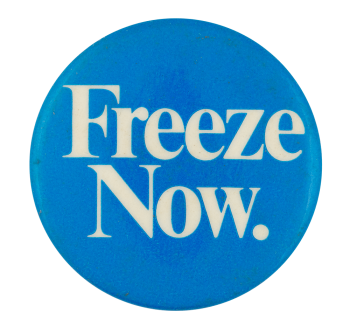| Category | |
|---|---|
| Additional Images | |
| Sub Categories | |
| Text on Button | Freeze Now. |
| Image Description | White text on a blue background |
| Curl Text | CALIF. NUCLEAR FREEZE CAMP. 415-986-7605 union bug |
| Back Style | |
| The Shape | |
| The Size | |
| Year / Decade Made | |
| Additional Information | During the 1980s, pressure for the United States to reach an agreement with Soviet Russia to halt all testing and development of nuclear weapons and to "freeze" the arms race gave way to a large movement of protests and demonstrations. The grassroots organizing was influential and played a major role in nuclear disarmament and the prevention of nuclear war. The movement began in 1980 when Dr. Randall Forsberg published the "Call to Halt the Nuclear Arms Race", which was quickly endorsed by most major peace organizations. Within a few years, the Nuclear Freeze became the center of the Democratic platform and the Freeze resolution passed the house of Representatives with unanimous Democratic support in 1982. The Freeze campaign eventually influenced Reagan to reverse his stance, which had previously been staunchly against regulation of nuclear testing. He later signed the INF Treaty with Mikhail Gorbachev which began unilateral disarmament of nuclear weapons. |
| Sources |
Wittner, Lawrence S. (December 5, 2010). "The Nuclear Freeze and Its Impact". Arms Control Today. Waller, Douglas C. (1987). Congress and the nuclear freeze : an inside look at the politics of a mass movement. Amherst, Mass.: University of Massachusetts Press. |
| Catalog ID | CA0727 |


